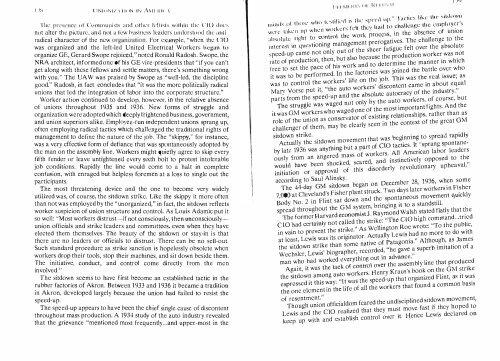CONTENTS - ouroboros ponderosa
CONTENTS - ouroboros ponderosa
CONTENTS - ouroboros ponderosa
You also want an ePaper? Increase the reach of your titles
YUMPU automatically turns print PDFs into web optimized ePapers that Google loves.
, IS I INII )NJ/,\ III IN IN AMI IW \<br />
, . , _<br />
_<br />
The 11rl:" Sl" '('" ,-, 0 " ( '<br />
'<br />
II I l lists WIIIIIIl tile ('It> dIll'S<br />
.<br />
not alter the picture , and n(lt a ' I' cw , , HISIIlCSS leaders , tim I crslood the allti<br />
I.H11llHl IlIStS and oH . - I ·r '. .<br />
. ' . "<br />
. .<br />
radical character of the new ' Ofoamzatlon For c · I "<br />
, xamp e, when the ClO<br />
was organized and the left-led United " ' Eleetncal Workers hegan to<br />
organize GE, Gerard Swope re'oi d<br />
NRA architect, informed one f i G ;:<br />
d Roald Radosh;, Swope, Ihe<br />
e _ presIdents that If you can't<br />
get along with these fellows ' and . se ' ttl e matters, there's something wrong<br />
with you " The UAW a d y :vope as "well-led, the discipline<br />
good." Radosh " in fact ':CrU dlse' s th al It was the more p 0 l't' 1 Ica 11 y radical<br />
.<br />
UnIons that led the integration of labor Illto ' thc corporate structure."<br />
Worker action continued to d eve ] op howcvcr<br />
' th I '<br />
of unions Ihroughout 1 9 ' III e re atlve absence<br />
35 and 1936 , N ew forms 01 struggle and<br />
organization were adopted which de ep I y f' fIg htened<br />
bus mess, government,<br />
often employing radical t ctics P ependent unions sprang up,<br />
- ;<br />
I<br />
and union superiors alike Em I<br />
" ged the tradllIonal nghts of<br />
management to der Ille t h e nature of the Job The " s 'k' IPPY, " lor c Instance,<br />
·<br />
was a very effective form of defia n e t h" at was spJlltaneously adopted by<br />
the man on the assembly Ii W<br />
.<br />
r ers mIght qUIetly agree to skip every<br />
fifth fender or leave untig ne<br />
, every sixth bolt to protest intolerable<br />
job conditions. Rapidly th e lme<br />
would come to a h' lt<br />
. .<br />
.<br />
a m complete<br />
contUSIon, with enraged but hel p Iess ' . f oremen at a loss to single out the<br />
participants.<br />
The most threatening device and the<br />
one to become very widely<br />
utilized was, of course the sitdo wn s t 'k n , e. LIke the skippy it more often<br />
than not was employed by the "<br />
.<br />
uc ure an control As Lo UlS Ad amlC . put it<br />
so we I I: "Most workers distrust if t nsClouSly, then unconsciously<br />
union officials and strike leaders a<br />
<br />
ommlttees, even when they have<br />
elected them thcmselves The beau f the sItdown or stay-in is that<br />
worker suspicion of u nion str<br />
unO<br />
rgan<br />
there are no leaders or fficials to i<br />
t<br />
d lzed, " in fact, the sitdown reflects<br />
. '<br />
S uch standard proeedure as strike san :us here can be no sell-out.<br />
t T<br />
on IS hopelessly obsolete when<br />
. <br />
workers drop their tools stop th elr a mes, and sit down beside them,<br />
The initiative conduct" and<br />
t<br />
, con ro come directly from the men<br />
involved.'"<br />
rubber factories of Akron , Bet w<br />
1 9 3 me an establIshed tactic in the<br />
in Akron, developed Iar o ely be en<br />
and 1<br />
936 It became a tradition<br />
h<br />
The sitdown seems to have first bee<br />
speed-up.<br />
<br />
ause t e umon had tarled to resist the<br />
The speed-up appears to have been th e e h' Ie f smgle ' cause of discontent<br />
throughout mass production. A 1934 . study<br />
01 the auto mdustry revealed<br />
that the grievance "mentioned m ost f requently ... and upper-most in the<br />
.<br />
Illilids oj Ih()Sl' will) tl'slifil-d is the specd tip." Tac1ics like lile sittinwll<br />
were take II up when wor"'-rs fell they had to challenge the employer's<br />
absolute rihl to control the work process, in the absence of union<br />
interest in '111l."tioning management prerogatives. The challenge to the<br />
speed-up came not only out of the sheer fatigue felt over the absolute<br />
rate of production, then, but also because the production worker was not<br />
free to set the pace of his work and to determine tbe manner in which<br />
it was to be performed. In the factories was joined the battle over who<br />
was to control the workers' life on the job. This was the real issue; as<br />
Mary Vorse put it, "the auto workers' discontent came in about equal<br />
parts from the speed-up and the absolute autocracy of the industry."<br />
The struggle was waged not only by the auto workers, of course, but<br />
it was GM workers who waged one of the most important fights, And the<br />
role of the union as conservator of existing relationships, rather than as<br />
challenger of them, may be clearly seen in the context of the great GM<br />
sitdown strike.<br />
Actually the sit down movement that was beginning to spread rapidly<br />
by latc 1936 was anything but a part of ClO tactics. It "sprang spontane<br />
ously from an angered maSS of workers, All American labor leaders<br />
would have been shocked, scared, and instinctively opposed to the<br />
initiation or approval of this disorderly revolutionary upheaval,"<br />
according to Saul Alinsky.<br />
The 44-day GM sitdown began on December 28, 1936, when some<br />
7,000 at Cleveland's Fisher plant struck , Two days later workers in Fisher<br />
Body No, 2 in Flint sat down and the spontaneous movement quickly<br />
spread throughout the GM system, bringing it to a standstill,<br />
The former Harvard economist J . Raymond Walsh stated flatly that the<br />
CIa had certainly not called the strike: "The cia high eommand ... tried<br />
in vain to prevent the strike." As Wellington Roe wrote: "To the public,<br />
at least, Lewis was its originator. Actually Lewis had n O more to do with<br />
the sitdown strike than somc native of Patagonia." Althougb, as James<br />
Wecbsler, Lewis' biographer, recorded, "he gave a superb imitation of a<br />
man who bad worked everything out in advance."<br />
Again, it was the lack of control over the assembly line that produced<br />
the sitdown among auto workers, Henry Kraus's book on the GM strike<br />
expressed it this way: "It waS the speed-up that organized Flint, as it was<br />
the one element in the life of all the workers that found a common basis<br />
of resentment."<br />
Though union officialdom feared the undisciplined sitdown movement,<br />
Lewis and the CIa realized that they must move fast if they hoped to<br />
keep up with and establish control over it. Hence Lewis declared on<br />
I /1,






